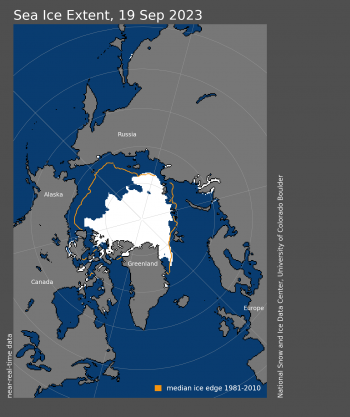The surface waters of our polar oceans freeze seasonally, forming a layer of sea ice that varies in thickness from centimeters to meters. The era of polar orbiting satellites has enabled the monitoring of sea ice distribution for more than four decades.
Seasons are reversed between the Northern and Southern hemispheres, so the sea ice maximum and minimum occur at different times of the year. Generally speaking, around mid-September the extent of the sea ice at the south pole is reaching a maximum, while in the Arctic it is approaching a minimum in September as our Northern Hemisphere summer comes to an end.

This year, the sea ice amount around Antarctica has fallen to a record low. Satellite observations indicate the sea ice extent around Antarctica peaked on Sept. 10. At that time, sea ice covered 6.55 million square miles, which is the lowest winter maximum since satellite records began in 1979. That’s about 386,000 square miles less ice than the previous winter low, set in 1986. The extent of the summer’s Antarctic sea ice also hit a record low in February, breaking the previous mark, set in 2022.
Arctic sea ice reached its minimum extent for this year on Sept. 19, covering 1.63 million square miles. This 2023 minimum extent is the sixth-lowest in the nearly 45-year satellite record. For reference, the combined surface area of the Great Lakes is 94,250 square miles.
The satellite data show a trend in sea ice extent over the Arctic that is decreasing annually at a rate of 4%, plus or minus 1%, per decade. The reduction of Arctic sea ice is rapid, as the northern polar region is warming four times faster than the global average. Over the Southern Hemisphere, satellite data shows no significant trend in sea ice extent. The climate change associated with global warming contributes to melt glaciers in Antarctica, which impacts sea ice extent around the continent.
Steve Ackerman and Jonathan Martin, professors in the UW-Madison department of atmospheric and oceanic sciences, are guests on WHA radio (970 AM) at 11:45 a.m. the last Monday of each month. Send them your questions at stevea@ssec.wisc.edu or jemarti1@wisc.edu.

